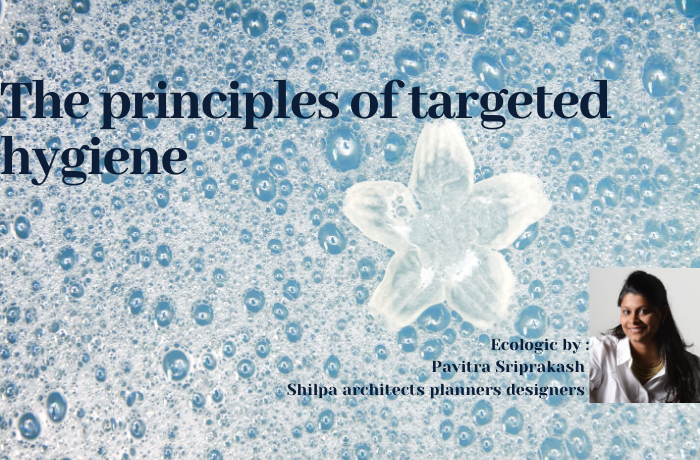10-Jun-2020 : Pavitra Sriprakash, Director and Chief Designer at Shilpa Architects Planners Designers writes a weekly column on Sustainability for The New Indian Express titled “ECOLOGIC”. This week’s article talks about targeted Hygiene and the design of surfaces in a post-COVID world.
Full article below: (Also available at The New Indian Express Website)
The principles of targeted hygiene
Glass, wood, metal and concrete — these are typically the materials in any architect’s palette. As design is quickly adapting to post-COVID conditions, it is imperative for the creators of surfaces to start thinking about these materials from a sustainability as well as ‘virus’ point of view.
A current project of mine used a lot of glass in the façade. While evaluating all the usual parameters such as radiation, reflectivity and transparence that I typically study, I also had to look at the life span of coronavirus on glass doors before taking a final call on the material specification!
According to WebMd, “The coronavirus that causes COVID-19 mainly spreads from person to person. When someone who is infected coughs or sneezes, they send droplets containing the virus into the air. A healthy person can then breathe in those droplets. You may also catch the virus if you touch a surface or object that has the virus on it and then touch your mouth, nose, or eyes.”
However, the virus can live for hours to days on surfaces around your homes and offices like countertops and doorknobs. How long it survives does depend on the material the surface is made from. Since we encounter these daily, it is good to understand when and how often to schedule maintenance of these surfaces in our homes and offices. We also need to balance cleaning, so we are not using up too many harmful chemicals while trying to stay safe. The aim should be to learn how to use the principles of targeted hygiene to help protect from coronavirus and break the chain of infection.
Metal, glass, ceramics and paper have been shown to support the virus for the longest — a period of up to five days. Wood has kept the coronavirus alive on it for up to four days. Plastics support the virus up to three days. Other materials like stainless steel, copper, cardboard ranges from a few hours to a little over a day. With this in mind, targeted hygiene practices need to particularly focus on surfaces that are frequently touched by you or your family.
Every home is different, but common high-touch surfaces include: door handles, tables, chairs, handrails, kitchen and bathroom surfaces, taps, toilets, light switches, mobile phones, computers, tablets, keyboards, remote controls, game controllers and favourite toys. According to the CDC and UNICEF, if a surface is dirty, first clean it with soap or detergent and water. Then use a disinfectant product containing alcohol (of around 70 per cent) or bleach.
The top recommended product for killing coronavirus currently is sodium hypochlorite bleach, which is a powerful disinfectant. This bleach is often used to clean toilets, but it can also be diluted at home to clean floors and frequently touched areas. As this is a potent chemical it is important to follow precautionary methods while applying the product, such as wearing gloves and making sure you have good ventilation.
Unfortunately, vinegar and other natural products are not recommended against coronavirus.
There is more research to be done around natural products and their efficacy against the virus. Go ahead, clean your surfaces as and when required through a targeted hygiene approach knowing how long between cleaning and what to clean it with. Stay clean, stay healthy.



